A child naming or naamkaran ceremony is an important occasion for parents to choose their newborn name by observing traditional rituals and astrological naming laws. This is a formal and holy function attended by family members, friends, and relatives who are gathered and shower their blessings on the baby for his healthy life and well-being. Scroll down to read all about the baby naming ceremony (Naamkaran).
What Is Naamkaran?
Naamkaran or baby naming ceremony is a very important Hindu rite after a child’s birth. In the presence of family and friends, it is a formal ceremony held. Naamkaran is a Sanskrit word that can be broken down as Naam-name and Karan-create. For every person who is born, it is one of the 16 Hindu samskaras or rituals to be performed.
Most castes and communities in Hinduism conduct this ceremony, but the rituals can differ according to the region. This ceremony is often carried out within a few weeks or a few months of birth, depending on the regional beliefs and traditions. The naming ceremony is a very happy ritual, and typically the first major Hindu ritual for the child. After the extra-careful days of pregnancy and the tension of childbirth, this is the time when friends and family come together to welcome the new baby, and the child is often officially introduced to friends and family.

Image Source – Pixabay
When Is The Naamkaran Held?
In accordance with the Hindu tradition, after the Jaatakarma, which is carried out immediately after birth, the naming ceremony should be performed. However, this ritual is rarely carried out these days, since most births take place in hospitals. This practice involves the father of the newborn baby feeding honey and the ghee of the newborn baby.
Naamkaran should be held either 11 days after birth or on an astrologer’s chosen auspicious day. However, before the child completes one year, it should be done. However, since both the mother and the baby must heal from the stress of childbirth, this ceremony should be avoided within the first 11 days of birth.
How is the name chosen by Hindu tradition?
Astrology is used to select a child’s name for most Hindu families. It is recommended to always obey “birth star or janma nakshatra” in the starting letter of the name. The first letter is often chosen based on the date of birth or planetary place of birth.
5 general principles for choosing the child’s name
- Maasa Naama-As in the Hindu calendar, the name is chosen according to the birth month.
- Nakshatra Naama-In accordance with the birth star or janma nakshatra, the name is selected.
- Kuladevatha Naama – The family deity’s name will be selected.
- Raashi Naama – The name is selected at the time of birth in accordance with the sun sign or the moon sign.
- Vyavahaara Naama-This is the name the parents and the family would like their child to address.
Sometimes a grandparent or the deceased ancestor’s name may be given to the child.

Image Source – babydestination.com
Baby Naming Ceremony Ritual
While this is a traditional Hindu ritual, it differs greatly from the local and community traditions. A priest performs the service. In a priest’s prayer and singing the Vedic mantras, mothers and fathers begin the rite. Sometimes before the ceremony to pray for the newborn’s long lives, a havan/homa is also done.
The priest provides the gods with meditation, the five elements (Agni-Fire, Bhoomi-Earth, Aakash-Space, Jal-Water, and Vayu-Air), and the ancestors’ spirits. On rice that is spread on a silver tray, the father writes the names selected. The father whispers the vyavahaara naama in the right ear of your child three times.
In some families, in the right ear, the paternal aunt or maternal uncle whispers the name, and in some cultures, the name is whispered by any of the grandparents. This ritual is accompanied by the child’s parents taking blessings from the family’s elders. The members of the family and friends then shower the child with different gifts. Members of the family traditionally offer gold ornaments, silk clothing, silver coins, cash, etc. Nowadays, everybody likes to give parents presents such as prams, cribs, high chairs, bathtubs, blankets, winter wear, clothing, etc. that can be of great use.
In certain regions, other ceremonies such as cradle ceremony and ear-piercing ceremony are accompanied by name ceremony. The Cradle Ceremony is carried out in a ritualistic way by placing the child in a decorated cradle. In the ear-piercing ceremony, at the place to be pierced, vermilion is used to put a dot on the ears of the child. To pierce the baby’s ears, a goldsmith proficient in ear piercing or a doctor is named. Gold earrings given to the pierced ear by the maternal grandparents are inserted.
Tips To Choose A Name
- Choose a name that is easy to pronounce and spell.
- It is often recommended that you select a name that is a noun and not an adjective or superlative when selecting a Sanskrit name.
- Many parents choose to retain Sanskrit-derived names. Grammatically and not by meaning, the Sanskrit nouns are divided into masculine, feminine, and neutral genders.
- Make sure you pick an acceptable word that suits your baby’s gender.
- Make sure that the name doesn’t have an awkward meaning in Indian languages if you want a name in Greek, Persian, etc.
A baby naming ceremony is a very special way to celebrate the newborn’s entry into the family. According to customs and beliefs, it is a way of showering him with blessings, thereby cementing a healthy and stable future for him.
Also Read: Significance And Procedure Of Annaprashan Ceremony













